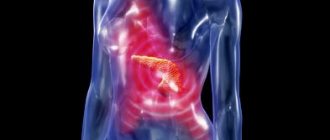- The most common causes of abdominal pain in children
- Causes of abdominal pain depending on the age of the child
- Diagnostics
- Treatment of abdominal pain
Most often, children complain of such ailment as abdominal pain.
It can appear for any reason and at any age. Only an experienced pediatrician can identify the exact cause of discomfort in the abdomen. Abdominal pain can be different - short-term and long-lasting, sharp and mild, local and widespread. In any case, you cannot wait until the painful symptoms intensify and become unbearable. If the discomfort is not caused by overeating, then you should immediately consult a doctor.
Main causes and their symptoms
Table 1. The most common causes of abdominal pain in a child.
| Causes | Symptoms |
| Colic | The appearance of colic is most typical for patients aged 3-4 months. They are accompanied by a deterioration in the child’s well-being with pronounced anxiety, crying, bending of the legs, tension and constant changes in body position. After taking up a vertical position, covering the abdomen with a warm diaper or drinking dill water, the severity of symptoms decreases and the child calms down. |
| Flatulence | The development of flatulence is accompanied by anxiety in the child. Despite an initially good appetite, he may abruptly refuse food. Lies mostly with knees bent. Frequent regurgitation, seething in the abdomen and painful release of gases, followed by relief of well-being, also appear. |
| Dysentery | The appearance of dysentery is characterized by a pronounced deterioration in health. An increase in body temperature is accompanied by increasing intoxication, weakness, and even loss of consciousness. Intestinal symptoms are expressed by single vomiting and frequent frequent stools, which are initially green in color with mucus or streaks of blood. After 2-3 illnesses, stool becomes extremely scanty. There may only be rumbling and tenesmus. |
| Viral infection | Children over five years of age are most often exposed to the development of viral infection. The disease is characterized by the appearance of symptoms of intoxication with dehydration, weakness, lethargy and loss of appetite. The temperature rises slightly. Dyspeptic symptoms are characterized by frequent bowel movements and vomiting, which do not bring relief. The stool is profuse with undigested pieces of food and an unpleasant odor. The patient may also be bothered by constant rumbling in the abdomen, flatulence and the appearance of cracks in the anus. The most dangerous signs of dehydration are those that develop within a short period of time. |
| Constipation and diarrhea | The development of constipation is manifested by the appearance of heaviness in the lower abdomen and an aching pain syndrome. The last bowel movement is noted several days ago. Symptoms of intoxication have not yet developed. Diarrhea is manifested by frequent bowel movements, which do not always bring relief. In this case, rumbling in the abdomen and spasmodic pain may develop. Due to frequent bowel movements, irritation develops in the rectal area. |
| Lactose intolerance | The disease is characterized by the appearance of pain half an hour after eating. They are spasmodic in nature, accompanied by flatulence, colic, severe bloating and regurgitation. |
| Gastritis stomach ulcers | Pathologies are manifested by initially aching pain, which can change to acute pain in the upper abdomen. In addition, nausea, vomiting, loss of appetite and weakness occur. |
| Parasites | The most common cause of abdominal pain in a child is roundworms. Symptoms may resemble colic, but are much less severe. However, they are regular. Headaches, flatulence and itching in the anus may occur, occurring mainly in the evening or at night. |
| Dyspepsia | Symptoms of dyspepsia develop one or two hours after eating and are accompanied by abdominal pain, flatulence, increased frequency of stools with an unpleasant odor, undigested food particles, and mucus. In addition, loss of appetite, frequent regurgitation and vomiting are possible. |
| Appendicitis | The disease is accompanied by the appearance of aching pain in the right iliac region or lower abdomen with an increase in temperature and an increase in intoxication. In the initial stages, one-time vomiting is possible. As the disease progresses, the pain becomes more intense and acute. |
| Pancreatitis | The development of pancreatitis is most typical for children aged 13-15 years. The patient is concerned about pain in the upper abdomen of a girdle and aching nature. Body temperature rises slightly. Vomiting and nausea occur, which intensify after eating, as well as dyspeptic symptoms caused by impaired enzyme production. |
| Intestinal obstruction | Obstruction is characterized by the appearance of diffuse pain in various parts of the abdomen, mainly in the umbilical region. Vomiting, passing gas or stool may occur once. As the disease progresses, bloating and intoxication with absence of bowel movements increases. |
| Intussusception | Intussusception is accompanied by the appearance of sharp paroxysmal pain in the abdomen, which intensifies after 10-15 minutes. The child behaves restlessly, screams, bends his legs to his stomach and breaks out in a cold sweat. Against the background of intestinal obstruction, vomiting, regurgitation and single passage of feces may occur. |
| Menstrual pain in girls | The development of menstrual pain is most often a concern in the first days of bleeding. There may be discomfort or pain that is aching in nature, radiating to the sacrum or coccyx. In addition, you may experience dizziness, weakness, decreased blood pressure, and cold, sticky sweat. |
| Crick | Sharp, paroxysmal pain that intensifies when walking may be associated with stretching of the muscles of the anterior abdominal wall. It may occur after physical strain, coughing or vomiting. The patient has a good appetite, no vomiting and no bowel movements. |
Features of acute gastritis
Inflammation of the mucous membrane appears due to negative external factors: poor nutrition, infections, consumption of expired products. Children can swallow substances containing toxins and poisons: household chemicals, drugs for adults, etc. They provoke irritation or burns of the mucous membrane, as a result, acute inflammation occurs.
Depending on the degree of damage to the mucous membrane, gastritis has varying degrees of severity and symptoms:
- with superficial inflammation, one-time vomiting and stomach pain occur;
- with deep inflammation, prolonged vomiting and stomach pain appear;
- when superficial erosions form due to inflammation, severe pain, prolonged vomiting, and general weakness appear;
- deep destruction and inflammation provoke similar, but very severe symptoms with dehydration against the background of incessant vomiting.
The first degree of the disease does not pose a threat and goes away without a trace with proper treatment. The second to fourth require specialized help because they can provoke gastric bleeding, dehydration, and intoxication.
Stomach ache - first aid
If you experience abdominal pain associated with poisoning, ensure you drink plenty of fluids. To do this, use only clean drinking water, as well as liquids that prevent the development of dehydration.
In order to remove toxins, it is allowed to use enterosorbents, for example, activated carbon. They will reduce the severity of diarrhea and also help remove the source of infection and toxins.
If the cause is unclear, as well as the persistence of symptoms with deterioration of well-being, you should not self-medicate. In the near future, you need to call an ambulance or go to a medical facility yourself.
Recommended video:
How do you know if your child has a stomach ache?
If the child cannot yet say what hurts, parents have to guess for themselves what is bothering their baby. Small children react to any pain by crying, however, if their tummy hurts, then in most cases this can be determined.
When gas accumulates, the tummy becomes noticeably rounded and becomes hard to the touch. The child pulls his legs towards his stomach, shudders for no apparent reason, and refuses to eat. If such signs appear, do not take risks - show the child to the doctor.
First aid before the doctor arrives
The main activities that should be carried out by others or parents before the ambulance arrives include:
- Avoid taking medications, in particular those with an analgesic effect. This will make it difficult to make a diagnosis in the future.
- Constant monitoring of body temperature. When the temperature rises to 38 degrees, measurements must be taken every 15-20 minutes and the resulting values recorded.
- Provide plenty of fluids. If vomiting, loose stools and abdominal pain occur, it is allowed to take pure still water, as well as solutions that can replenish the loss of fluid from the bloodstream, preventing dehydration. It is forbidden to give your child juices, lemonades, coffee or tea.
- Providing peace. The child must be put to bed so that he can take a position that is comfortable for him and relieves pain. Avoid eating.
Prevention of abdominal pain in children
Preventive measures aimed at reducing the severity of pain in children include:
- Normalization of nutrition. Restoring the diet, as well as selecting the optimal diet, helps prevent the development of abdominal pain, which can be functional in nature. To do this, you need to adhere to a regular diet with maximum limitation of snacks, as well as the consumption of salty, smoked, spicy and fried foods. Preference should be given to fermented milk products, fruits, vegetables, meat and poultry, as well as various cereals. It is important to avoid long breaks between meals.
- Creating a favorable psycho-emotional environment at home. Parents need to provide a psychologically comfortable environment for the child’s life, protecting him from quarrels, scandals, showdowns, as well as other adverse factors.
- Regulation of sleep and rest patterns. To prevent the development of pain, prevent a decrease in immunity, it is necessary to restore full sleep, eliminate excessive stress, and also normalize the work and rest regime.
- Compliance with personal hygiene rules. A prerequisite for reducing the incidence of abdominal pain is hand washing. This procedure is mandatory before eating, after coming from outside, visiting the toilet, and after contact with animals.
- Timely treatment of diseases occurring in acute or chronic form. This will prevent a decrease in immunity.
Functional pain—how to help your child?
The development of functional pain is common in children aged 7 to 15 years. This condition is accompanied by a pronounced deterioration in well-being, but even with a thorough diagnosis and a complete examination of the patient, the cause cannot be determined. Their appearance is not associated with the presence of pathology of a surgical or infectious nature.
Suspected causes that may cause functional pain include:
- Overwork.
- Exposure to severe stress or nervous tension.
- Functional dyspepsia or impaired stomach function, accompanied by painful digestion.
- Irritable bowel syndrome, which is associated with disruption of the digestive tract without organic pathology.
- Abdominal migraine. The appearance of pain is accompanied by a sharp deterioration in health with the development of nausea, vomiting and pallor of the skin.
Recommended video:
Despite the fact that functional pain does not pose a threat to the life and health of the patient, it can significantly impair the quality of life. Therefore, to alleviate the child’s condition, it is necessary:
- Create a calm atmosphere and provide care from loved ones to reduce the severity of stress. Eliminating negative reactions will help the nervous system recover, relieving tension.
- Dieting. Daily consumption of cereal products, fresh vegetables and fruits, as well as dried fruits, while simultaneously eliminating fast food, spicy, smoked and salty foods, alleviates symptoms and also normalizes the functioning of the digestive tract.
- Choose the right medications. If the functional nature of the pain is confirmed, there is no need to endure the pain syndrome. The child is allowed to take antispasmodics or mild non-steroidal anti-inflammatory drugs.
- Keeping a disease diary. It is important for the child to record the observations that he notes during the development of pain. This will help eliminate the cause of the disorders by comparing medical history data, reactions to medications, as well as the conditions under which the pain subsides.
Can I give painkillers?
Taking painkillers for abdominal pain in a child of unknown etiology is prohibited by specialists. These drugs reduce the severity of pain, thereby distorting the clinical picture of the disease.
In the future, upon admission to the hospital, it will be more difficult to make a diagnosis and select the necessary diagnostic and treatment tactics. Therefore, if abdominal pain occurs, it is necessary to urgently contact a medical institution without self-medicating.
Despite the fact that the causes of abdominal pain in children can be varied, self-treatment is not allowed. This is associated with a high risk of complications and threat to the patient’s life.
The child complains of pain in the upper abdomen.
Peptic ulcer of the stomach and duodenum is an inflammatory disease that occurs with ulcerations of the mucous membrane of the stomach and duodenum. The causes and predisposing factors are the same as for gastritis.
With gastritis and peptic ulcers, gastroesophageal reflux often occurs - acidic gastric juice enters the esophagus, which is manifested by belching, pain in the stomach after eating, and heartburn.
With peptic ulcers, these symptoms are more pronounced.







